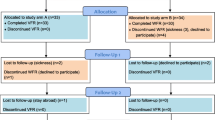Abstract
Accuracy and precision of nutritional data are crucial in estimating effects in nutritional epidemiology. Because it is known that such data are usually flawed, studies have been designed to estimate both the validity of diet assessment methods in measuring “true” diet and the reliability of these methods in providing nutrient data that are at least reproducible. In these studies, validity and reliability have often been gauged by computing correlation coefficients between two or more estimates of diet and testing the coefficeint's departure from 0. We propose that the correlation coefficient may be inappropriate in these studies as a measure of association. If correlation coefficients are presented, we suggest that one should also present confidence intervals and test the departure of the coefficient from approximately 1 rather than 0. We have examined this approach using dietary data from various studies. We have computed 95% confidence intervals of the correlation coefficients and have tested Ho:rho=0.95 as an approximation of rho=1.00. In all of the studies selected, comparisons produced correlation coefficients statistically significantly different from both 0.95 and 0. Due to the dependence of the correlation coefficient on factors unique to individual studies, it is recommended that other techniques be used to assess agreement between nutrient scores derived in reliability or validation studies. Viable options include linear regression, analyses of the standard deviations of the differences between scores, and examinations of the intraclass correlation coefficient.
Similar content being viewed by others
References
BazzarreT.L., YuhasJ.A. (1983): Comparative evaluation of methods of collecting food intake data for cancer epidemiology studies. Nutr Cancer 5: 201–214.
BlockG. (1982): A review of validations of dietary assessment methods. Am. J. Epidemiol. 115: 492–505.
BorrelliR., ColeT.J., diBiaseG., ContaldoF. (1989): Some statistical considerations on dietary assessment methods. Eur. J. Clin. Nutr. 43:453–463.
BuremaJ., VanStaverenW.J., Van DenBrandtP.A. (1988): Validity and Reproducibility. in: Cameron ME, Van Staveren WA, eds. Manual on Methodology for Food Consumption Studies. Oxford: Oxford Univ. Press
ByersT., RosenthalR.I., MarshallJ.R., RzepkaT.F., CummingsK.M., GrahamS. (1983): Dietary history from the distant past: a methodological study. Nutr. Cancer 5: 69–77.
ChuS.Y., KolonelL.N., HankinJ.H., LeeJ. (1984): A comparison of frequency and quantitative dietary methods for epidemiologic studies of diet and disease. Am. J. Epidemiol. 119: 323–324.
DraperN.R., SmithH. (1981): Applied regression analysis, second edition. New York: John Wiley and Sons.
HankinJ.H., NomuraM.D., JamesL., TomidH. (1983): Reproducibility of a diet history questionnaire in a case-control study of breast cancer. Am. J. Clin. Nutr. 37: 981–985.
HebertJ.R., MillerD.R. (1988): Methodologic considerations for examining the diet-cancer link. Am. J. Clin. Nutr. 47:1068–1077.
JainM., HoweG.R., JohnsonK.C., MillerA.B. (1980): Evaluation of a diet history questionnaire for epidemiologic studies. Am. J. Epidemiol. 111: 212–219.
JensenO.M., WahrendorfF.J., RosenqvistA., GeserA.: (1984): The reliability of questionnaire-derived historical dietary information and temporal stability of food habits in individuals. Am. J. Epidemiol. 120: 281–290.
KarvettiR.L., KnutsL.R. (1979): Agreement between dietary interviews. JADA 79: 654–660.
KleinbaumD.G., KupperL.L., MorgensternH. (1982): Epidemiologic Research: Principles and Quantitative Methods. New York: Van Nostrand Reinhold Co.
KrantzlerN.J., MullenB.J., SchutzG.H., GrivettiL.E., HoldenM.S., MeiselmanH.L. (1982): Validity of telephoned diet recalls and records for assessment of individual food intake. Am. J. Clin. Nutr. 36: 1234–1242.
MahalkoJ.R., JohnsonL.K., GallagherS.K., MilneD.B. (1985): Comparison of dietary histories and seven day food records in a nutritional assessment of older adults. Am. J. Clin. Nutr. 42:542–553.
MiettinenO.S. (1985): Theoretical Epidemiology: Principles of Occurrence Research in Medicine. New York: John Wiley & Sons.
MorganR.W., JainM., MillerA.B., ChoiN.W., MathewsV., MunanL., BurehJ.D. (1978): A comparison of dietary methods in epidemiologic studies. Am. J. Epidemiol. 107: 488–499.
RäsänenL. (1979): Nutrition survey of Finnish rural children: IV. Methodological study comparing the 24-hour recall and the dietary history interview. Am. J. Clin. Nutr. 32: 2560–2567.
RäsänenL., PietinenP. (1982): A short questionnaire method of evaluation of diets. Prev. Med. 11: 669–676.
RohanT.E., PotterJ.D. (1984): Retrospective assessment of dietary intake. Am. J. Epidemiol. 120: 876–887.
Russell-BriefelR., GaggivlaA.W., KullerL.H. (1985): A comparison of three dietary methods for estimating vitamin A intake. Am. J. Epidemiol. 122: 628–636.
SnedecorG.W., CochranW.G. (1989): Statistical Methods. Ames Iowa: Iowa State University Press.
StuffJ., GarzaC., SmithE.O., NicholsB.L., MontandonC.M. (1983) A comparison of dietary methods in nutritional studies. Am. J. Clin. Nutr. 37: 300–306.
VanLeeuwenF.E., et al. (1983): An assessment of the relative validity of retrospective interviewing for measuring dietary intake. Am. J. Epidemiol. 118: 752–758.
VanStaverenW.A., DeBoerJ.O., BuremaJ. (1985): Validity and reproducibility of a dietary history method estimating the usual food intake during one month. Am. J. Clin. Nutr. 42:554–559.
WillettW.C., StampferM.J., UnderwoodB.A., SpeizerF.E., RosnerB., HennekensC.H. (1983): Validation of a dietary questionnaire with plasma carotenoid and alpha-tocopherol levels. Am. J. Clin. Nutr. 38: 631–639.
WillettW.C., SampsonL., StampferM.J., RosnerB., BainC., WitschiJ., et al (1985): Reproducibility and validity of a semiquantitative food frequency questionnaire. Am. J. Epidemiol. 122: 51–65.
Author information
Authors and Affiliations
Additional information
Corresponding author.
Rights and permissions
About this article
Cite this article
Hebert, J.R., Miller, D.R. The inappropriateness of conventional use of the correlation coefficient in assessing validity and reliability of dietary assessment methods. Eur J Epidemiol 7, 339–343 (1991). https://doi.org/10.1007/BF00144997
Issue Date:
DOI: https://doi.org/10.1007/BF00144997




